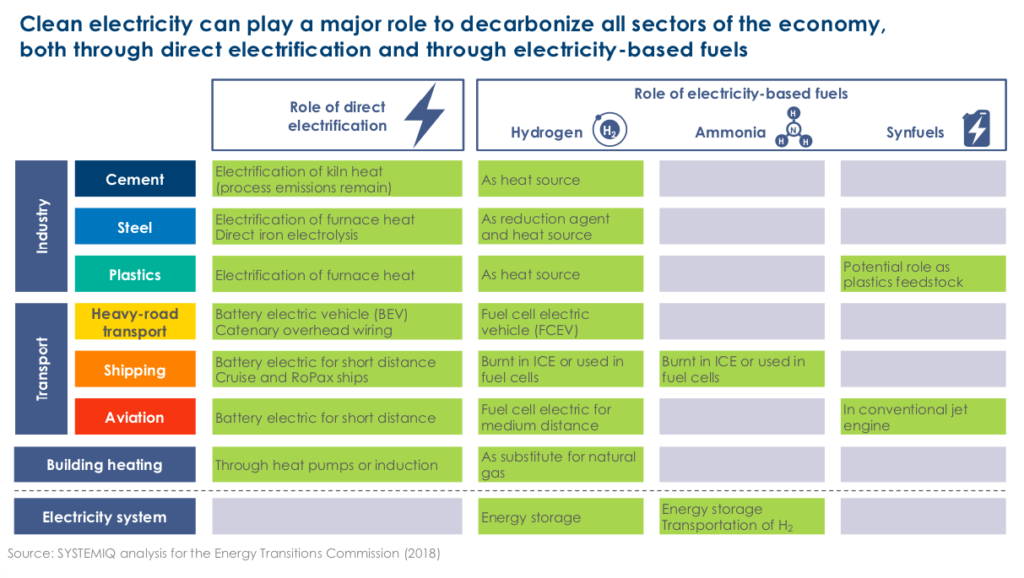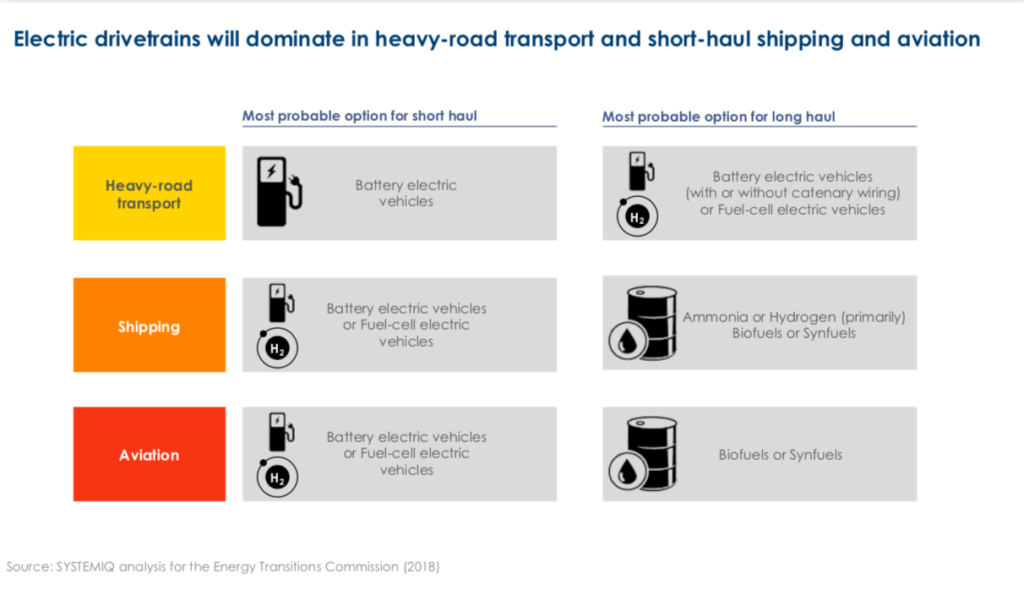Mission Possible: a roadmap for net-zero emissions in the heavy industry and heavy-duty transport sectors
By Trevor Brown on January 11, 2019
Mission Possible, a recent report published by the Energy Transitions Commission, presents an extremely detailed roadmap for “Reaching net-zero carbon emissions from harder-to-abate sectors by mid-century.” The report is designed to support the targets of the Paris Agreement by sending “a clear signal to policymakers, investors and businesses: full decarbonization is possible, making ambitious climate objectives achievable.”
Ammonia is one of the crucial solutions that make Mission Possible possible. In its 172-pages, the report details the technologies and the economics behind decarbonizing ammonia, the “likely” adoption of ammonia as the carbon-free fuel of choice for long-haul shipping, and the “key role” ammonia will play in enabling international trade in renewable power.
The Energy Transitions Commission (ETC) is “a coalition of business, finance and civil society leaders from across the spectrum of energy producing and using industries.” This report, which “was developed with contributions from over 200 industry experts over a 6-month consultation process,” focuses on those sectors of the economy that are most difficult to decarbonize: heavy industry (specifically cement, steel, and plastics) and heavy-duty transport (heavy road transport, shipping, and aviation).
These heavy-duty sectors are responsible for emissions of over 10 gigatons of CO2 per year, or 30% of total emissions from the energy and industry sectors. By 2050, if current trends continue, they will be responsible for emitting 16 gigatons of CO2 per year. To meet the goals of the Paris Agreement, heavy industry and heavy-duty transport must contribute their fair share of emission reductions. Fortunately, as Mission Possible makes clear, this is both technically and economically feasible.
To achieve even the 2°C goal, and to have any chance of reaching the aspired 1.5°C limit, it is essential for energy and industrial systems to achieve net-zero CO2 emissions … The ETC strongly believes that this is achievable by 2050 in developed economies and 2060 in developing economies … at a cost to the economy of less than 0.5% of global GDP.
However, this vital and technically possible transition will not be achieved unless policymakers, investors and businesses jointly take immediate and forceful action to transform economic systems.
This report therefore describes in turn:
A. Why reaching net-zero CO2 emissions from harder-to-abate sectors is technically and economically feasible;
B. How to manage the transition to net-zero CO2 emissions in heavy industry and heavy-duty transport;
C. What policymakers, investors, businesses and consumers must do to accelerate change.
Energy Transitions Commission, Mission Possible, November 2018
International trade in ammonia: a “key role” in enabling decarbonization
Mission Possible assesses a portfolio of supply-side decarbonization technologies, focusing on four main routes: electricity, bioenergy, carbon capture, and hydrogen.

Importantly, it considers both direct and indirect electrification of these sectors, seeing hydrogen produced using electrolyzers – and the ammonia produced from that hydrogen – as indirect electrification.
At the aggregate global level, there is easily sufficient land to support renewable electricity generation on the scale required, but with large regional variations. In favorable geographies like north-west China, mid-west US and the Middle East, renewable electricity could be produced at low cost in quantities exceeding local demand. But less favorable locations, with high population density or less favorable renewable resources, may need to draw on zero-carbon power sources that are less land-intensive and have higher capacity factors (e.g. nuclear or fossil fuels with carbon capture) or on imports of power (via long-distance transmission lines or in the form of hydrogen or ammonia) …
Key implications for policymakers:
– Electrolysis cost reduction is a key innovation priority, targeting capital costs of US$250/kW.
– CCS infrastructure needs to be developed to enable production of near-zero-carbon hydrogen from SMR plus CCS.
– Further reduction in fuel-cell costs and hydrogen tanks are also key priorities.
– International trade in hydrogen or ammonia is likely to play a key role, potentially requiring significant infrastructure investment.
Energy Transitions Commission, Mission Possible, November 2018
The report primarily sees private investment driving this energy transition, however it also identifies “investments in common infrastructure where governments need to play a coordination role, and, to some extent, a direct investment role, to ensure sufficiently rapid development.” These include scaling-up renewable power generation, increasing long-distance power transmission and strengthening the grid, and building out “port infrastructure and pipelines to transport new fuels like hydrogen and ammonia.”
Hydrogen and ammonia could potentially be produced on a very large scale at low cost in favorable locations and then internationally traded. This might be supported by shipping of new fuels (on a similar model as LNG today), which would require an adaptation of port infrastructure, or by long-distance pipelines.
Energy Transitions Commission, Mission Possible, November 2018
And this leads directly to one of the four “immediate actions” that Mission Possible identifies in its final chapter, calling on the public sector to “create a coalition of major international ports dedicated to new fuels.”
This coalition could have the double aim of (i) developing the necessary infrastructure for international trade of hydrogen and/or ammonia (which may be a growing activity for international ports at a time when international trade of fossil fuels should gradually wind down to meet the Paris objectives) and (ii) developing a battery recharging and hydrogen / ammonia refueling infrastructure in ports, as these are likely to become dominant fuels for the shipping industry over time.
Energy Transitions Commission, Mission Possible, November 2018
Ammonia: the “most probable option” for long-haul shipping
In the heavy-duty transportation sector, direct electrification using batteries almost always provides the most energy efficient short-haul option. However, batteries lack the energy density to enable longer journeys and, therefore, indirect electrification using ammonia as a carbon-free electricity-based fuel represents the “most probable option” for decarbonizing long-haul shipping.

However, as with every element of the energy transition, the cost of fuel switching is high and the economics of change are complex – although, not, perhaps, as high or as complex as previously reported.
For shipping … the impact of switching to biofuels or ammonia would be significant, possibly increasing voyage costs by as much as 120%, with an implied abatement cost of around US$350 per tonne of CO2 saved. If the ammonia was made using hydrogen produced from electricity, the cost would fall with the price of renewable electricity. But even with electricity available at US$20/MWh and hydrogen costing US$5c/kWh, using ammonia in a ship engine instead of HFO/MTO would increase voyage costs by around 50%, with an implied abatement cost of around US$150 per tonne of CO2 saved. Even such significant increases in freight costs, however, would only [add] 1% or less to final product prices of internationally traded goods …
The pace of transition will therefore be driven primarily by the cost of ammonia and biofuels production, carbon prices and regulation, rather than by the asset turnover cycle …
None of the increases in end-consumer prices are sufficiently large to be an argument against forceful policies to drive decarbonization.
Energy Transitions Commission, Mission Possible, November 2018